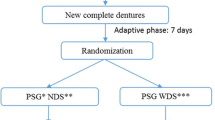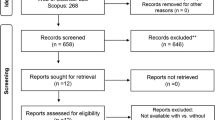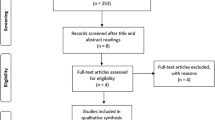Abstract
Objectives
There is no consensus in the literature about the impact of complete denture wear on obstructive sleep apnea (OSA). The goal of this randomized clinical study was to assess if complete denture wear during sleep interferes with the quality of sleep.
Materials and methods
Elderly edentulous OSA patients from a complete denture clinic were enrolled and received new complete dentures. An objective sleep analysis was determined with polysomnography performed at the sleep laboratory for all patients who slept either with or without their dentures.
Results
Twenty-three patients (74% females) completed the study with a mean age of 69.6 years and a mean body mass index of 26.7 kg/m2. The apnea and hypopnea index (AHI) was significantly higher when patients slept with dentures compared to without (25.9 ± 14.8/h vs. 19.9 ± 10.2/h; p > 0.005). In the mild OSA group, the AHI was significantly higher when patients slept with the dentures (16.6 ± 6.9 vs. 8.9 ± 2.4; p < 0.05), while in moderate to severe OSA patients, the AHI was not significantly different when sleeping with dentures (.30.8 ± 15.6 vs. 25.7 ± 7.5; p = 0.2). The supine AHI in mild patients was related to a higher increase in AHI while wearing dentures (12.7 ± 8.4/h vs. 51.9 ± 28.6/h; p < 0.001). A limitation of the study is that the mild OSA patients had a higher BMI when compared to the moderate to severe OSA patients. Ten out of 14 patients who preferred to sleep with their upper and lower dentures showed an increase in their AHI while wearing dentures to sleep.
Conclusions
Contrary to previous studies, we found that OSA patients may experience more apneic events if they sleep with their dentures in place. Specifically, in mild OSAS patients, the use of dentures substantially increases the AHI especially when in the supine position.



Similar content being viewed by others
References
Guilleminault C, Abad VC (2004) Obstructive sleep apnea syndromes. Med Clin North Am 88:611–630
Iber C, Ancoli-Israel S, Chesson AL, Quan SF (2007) The AASM manual for the scoring of sleep associated events: rules, terminology and technical specifications, 1st edn. American Academy of Sleep Medicine, Westchester
Young T, Peppard PE, Gottlieb DJ (2002) Epidemiology of obstructive sleep apnea: a population health perspective. Am J Respir Crit Care Med 165:1217–1239
Ancoli-Israel S, Kripke DF, Klauber MR, Mason WJ, Fell R, Kaplan O (1991) Sleep-disordered breathing in community-dwelling elderly. Sleep 14:486–495
Douglass CW, Shih A, Ostry L (2002) Will there be a need for complete dentures in the United States in 2020? J Prosthet Dent 87:5–8
Carlsson GE, Omar R (2010) The future of complete dentures in oral rehabilitation. A critical review. J Oral Rehabil 37:143–156
Felton DA (2009) Edentulism and comorbid factors. J Prosthodont 18:88–96
Lopes C, Esteves AM, Bittencourt LR, Tufik S, Mello MT (2008) Relationship between the quality of life and the severity of obstructive sleep apnea syndrome. Braz J Med Biol Res 41:908–913
Jean-Louis G, Kripke DF, Ancoli-Israel S (2000) Sleep and quality of well-being. Sleep 23:1115–1121
Emami E, Lavigne G, De Grandmont P, Rompré PH, Feine JS (2010) Perceived sleep quality among edentulous elders. Gerodontology. doi:10.1111/j.1741-2358.2010.00426.x
Endeshaw YW, Katz S, Ouslander JG, Bliwise DL (2004) Association of denture use with sleep-disordered breathing among older adults. J Public Health Dent 64:181–183
Erovigni F, Graziano A, Ceruti P, Gassino G, De Lillo A, Carossa S (2005) Cephalometric evaluation of the upper airway in patients with complete dentures. Minerva Stomatol 54:293–301
Bucca C, Cicolin A, Brussino L, Arienti A, Graziano A, Erovigni F, Pera P, Gai V, Mutani R, Preti G, Rolla G, Carossa S (2006) Tooth loss and obstructive sleep apnoea. Respir Res 7:8
Arisaka H, Sakuraba S, Tamaki K, Watanabe T, Takeda J, Yoshida K (2009) Effects of wearing complete dentures during sleep on the apnea–hypopnea index. Int J Prosthodont 22:173–177
Suenaga K, Sato T, Nishigawa G, Minagi S (1997) Relationship between size of denture foundation area and resorption of alveolar ridge in the edentulous mandible. J Oral Rehabil 24:315–319
Nuckton TJ, Glidden DV, Browner WS, Claman DM (2006) Physical examination: Mallampati score as an independent predictor of obstructive sleep apnea. Sleep 29:903–908
Koshino H, Hirai T, Yokoyama Y, Tanaka M, Toyoshita Y, Iwasaki K, Sudo E (2008) Mandibular residual ridge shape and the masticatory ability in complete denture wearers. Nihon Hotetsu Shika Gakkai Zasshi 52:488–493
Johnson A, Wildgoose DG, Wood DJ (2002) The determination of freeway space using two different methods. J Oral Rehabil 29:1010–1013
Myers ML (1982) Centric relation records—historical review. J Prosthet Dent 47:141–145
Buysse DJ, Reynolds CF 3rd, Monk TH, Berman SR, Kupfer DJ (1989) The Pittsburgh Sleep Quality Index: a new instrument for psychiatric practice and research. Psychiatry Res 28:193–213
Johns MW (1991) A new method for measuring daytime sleepiness: the Epworth sleepiness scale. Sleep 14:540–545
Bertolazi AN, Fagondes SC, Hoff LS, Pedro VD, Menna Barreto SS, Johns MW (2009) Portuguese-language version of the Epworth sleepiness scale: validation for use in Brazil. J Bras Pneumol 35:877–883
Lima PF, Medeiros AL, Araujo JF (2002) Sleep–wake pattern of medical students: early versus late class starting time. Braz J Med Biol Res 35:1373–1377
Rechtschaffen A, Kales A (1968) A manual of standardized terminology, techniques and scoring system for sleep stages of human subjects. Washington Public Health Service, US Government Printing Office, Washington
(1992) EEG arousals: scoring rules and examples: a preliminary report from the Sleep Disorders Atlas Task Force of the American Sleep Disorders Association. Sleep 15:173–184
Endeshaw YW, White WB, Kutner M, Ouslander JG, Bliwise DL (2009) Sleep-disordered breathing and 24-hour blood pressure pattern among older adults. J Gerontol A Biol Sci Med Sci 64:280–285
Martin JL, Mory AK, Alessi CA (2005) Nighttime oxygen desaturation and symptoms of sleep-disordered breathing in long-stay nursing home residents. J Gerontol A Biol Sci Med Sci 60:104–108
Chung S, Yoon IY, Lee CH, Kim JW (2009) Effects of age on the clinical features of men with obstructive sleep apnea syndrome. Respiration 78:23–29
Soga T, Nakata S, Yasuma F, Noda A, Sugiura T, Yatsuya H, Koike Y, Ozaki N, Nakashima T (2009) Upper airway morphology in patients with obstructive sleep apnea syndrome: effects of lateral positioning. Auris Nasus Larynx 36:305–309
Kotsiomiti E, Farmakis N, Kapari D (2005) Factors related to the resting tongue position among partially and completely edentulous subjects. J Oral Rehabil 32:397–402
Hansen CA, Axinn S (1984) Incidence of mandibular dysfunction symptoms in individuals who remove their complete dentures during sleep. J Prosthet Dent 51:16–18
Nevalainen MJ, Narhi TO, Ainamo A (1997) Oral mucosal lesions and oral hygiene habits in the home-living elderly. J Oral Rehabil 24:332–337
Compagnoni MA, Souza RF, Marra J, Pero AC, Barbosa DB (2007) Relationship between Candida and nocturnal denture wear: quantitative study. J Oral Rehabil 34:600–605
Baran I, Nalcaci R (2009) Self-reported denture hygiene habits and oral tissue conditions of complete denture wearers. Arch Gerontol Geriatr 49:237–241
Emami E, de Grandmont P, Rompre PH, Barbeau J, Pan S, Feine JS (2008) Favoring trauma as an etiological factor in denture stomatitis. J Dent Res 87:440–444
Marcus PA, Joshi A, Jones JA, Morgano SM (1996) Complete edentulism and denture use for elders in New England. J Prosthet Dent 76:260–266
Pietrokovski J, Levy F, Azuelos J, Tau S, Tamari I, Mostavoy R (1990) Oral findings in elderly nursing home residents in selected countries. 2. Soft tissue lesions and denture wearing habits. Gerodontology 9:75–81
de Castellucci BL, Ferreira MR, de Carvalho Calabrich CF, Viana AC, de Lemos MC, Lauria RA (2008) Edentulous patients’ knowledge of dental hygiene and care of prostheses. Gerodontology 25:99–106
Cartwright RD (1984) Effect of sleep position on sleep apnea severity. Sleep 7:110–114
Oksenberg A, Khamaysi I, Silverberg DS, Tarasiuk A (2000) Association of body position with severity of apneic events in patients with severe nonpositional obstructive sleep apnea. Chest 118:1018–1024
von Gonten AS, Rugh JD (1984) Nocturnal muscle activity in the edentulous patient with and without dentures. J Prosthet Dent 51:709–713
von Gonten AS, Palik JF, Oberlander BA, Rugh JD (1986) Nocturnal electromyographic evaluation of masseter muscle activity in the complete denture patient. J Prosthet Dent 56:624–629
Acknowledgments
The authors wish to thank the AFIP (Associação Fundo de Incentivo a Psicofarmacologia–Brazil) for the polysomnography exams, Ms. Mary Wong for providing statistical analysis, and Mrs. Clare Davies for editorial assistance. Author collaborations for this study were supported by Foreign Affairs and International Trade Canada by a grant agreement for Emerging Leaders in the Americas.
Author information
Authors and Affiliations
Corresponding author
Rights and permissions
About this article
Cite this article
Almeida, F.R., Furuyama, R.J., Chaccur, D.C. et al. Complete denture wear during sleep in elderly sleep apnea patients—a preliminary study. Sleep Breath 16, 855–863 (2012). https://doi.org/10.1007/s11325-011-0587-9
Received:
Revised:
Accepted:
Published:
Issue Date:
DOI: https://doi.org/10.1007/s11325-011-0587-9




